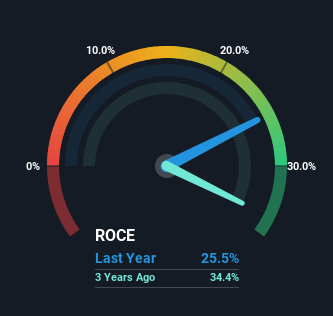
What are the early trends we should look for to identify a stock that could multiply in value over the long term? Typically, we'll want to notice a trend of growing return on capital employed (ROCE) and alongside that, an expanding base of capital employed. Put simply, these types of businesses are compounding machines, meaning they are continually reinvesting their earnings at ever-higher rates of return. So when we looked at Shera Energy (NSE:SHERA), they do have a high ROCE, but we weren't exactly elated from how returns are trending.
What Is Return On Capital Employed (ROCE)?
For those that aren't sure what ROCE is, it measures the amount of pre-tax profits a company can generate from the capital employed in its business. The formula for this calculation on Shera Energy is:
Return on Capital Employed = Earnings Before Interest and Tax (EBIT) ÷ (Total Assets - Current Liabilities)
0.26 = ₹458m ÷ (₹4.4b - ₹2.6b) (Based on the trailing twelve months to March 2024).
So, Shera Energy has an ROCE of 26%. That's a fantastic return and not only that, it outpaces the average of 18% earned by companies in a similar industry.
Check out our latest analysis for Shera Energy

Historical performance is a great place to start when researching a stock so above you can see the gauge for Shera Energy's ROCE against it's prior returns. If you'd like to look at how Shera Energy has performed in the past in other metrics, you can view this free graph of Shera Energy's past earnings, revenue and cash flow.
The Trend Of ROCE
When we looked at the ROCE trend at Shera Energy, we didn't gain much confidence. To be more specific, while the ROCE is still high, it's fallen from 42% where it was five years ago. However, given capital employed and revenue have both increased it appears that the business is currently pursuing growth, at the consequence of short term returns. If these investments prove successful, this can bode very well for long term stock performance.
On a side note, Shera Energy's current liabilities are still rather high at 60% of total assets. This effectively means that suppliers (or short-term creditors) are funding a large portion of the business, so just be aware that this can introduce some elements of risk. While it's not necessarily a bad thing, it can be beneficial if this ratio is lower.
In Conclusion...
While returns have fallen for Shera Energy in recent times, we're encouraged to see that sales are growing and that the business is reinvesting in its operations. Furthermore the stock has climbed 74% over the last year, it would appear that investors are upbeat about the future. So while the underlying trends could already be accounted for by investors, we still think this stock is worth looking into further.
On a final note, we found 3 warning signs for Shera Energy (2 make us uncomfortable) you should be aware of.
Shera Energy is not the only stock earning high returns. If you'd like to see more, check out our free list of companies earning high returns on equity with solid fundamentals.
New: Manage All Your Stock Portfolios in One Place
We've created the ultimate portfolio companion for stock investors, and it's free.
• Connect an unlimited number of Portfolios and see your total in one currency
• Be alerted to new Warning Signs or Risks via email or mobile
• Track the Fair Value of your stocks
Have feedback on this article? Concerned about the content? Get in touch with us directly. Alternatively, email editorial-team (at) simplywallst.com.
This article by Simply Wall St is general in nature. We provide commentary based on historical data and analyst forecasts only using an unbiased methodology and our articles are not intended to be financial advice. It does not constitute a recommendation to buy or sell any stock, and does not take account of your objectives, or your financial situation. We aim to bring you long-term focused analysis driven by fundamental data. Note that our analysis may not factor in the latest price-sensitive company announcements or qualitative material. Simply Wall St has no position in any stocks mentioned.
About NSEI:SHERA
Shera Energy
Engages in the manufacture and supply of winding wires and strips made primarily of copper and aluminum in India.
Adequate balance sheet low.
Similar Companies
Market Insights
Community Narratives




